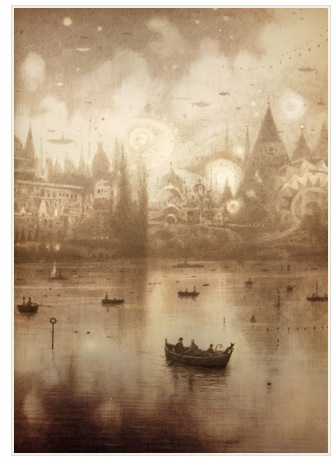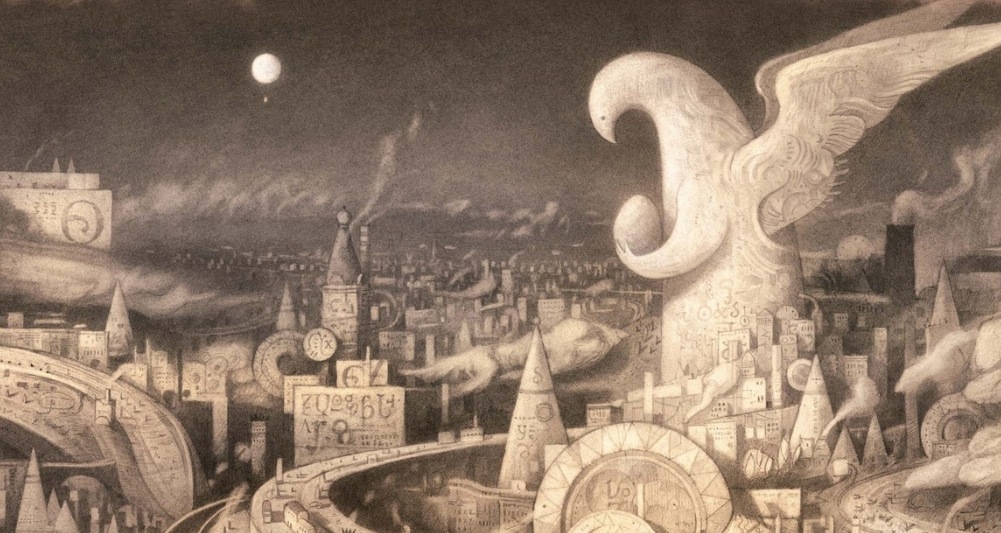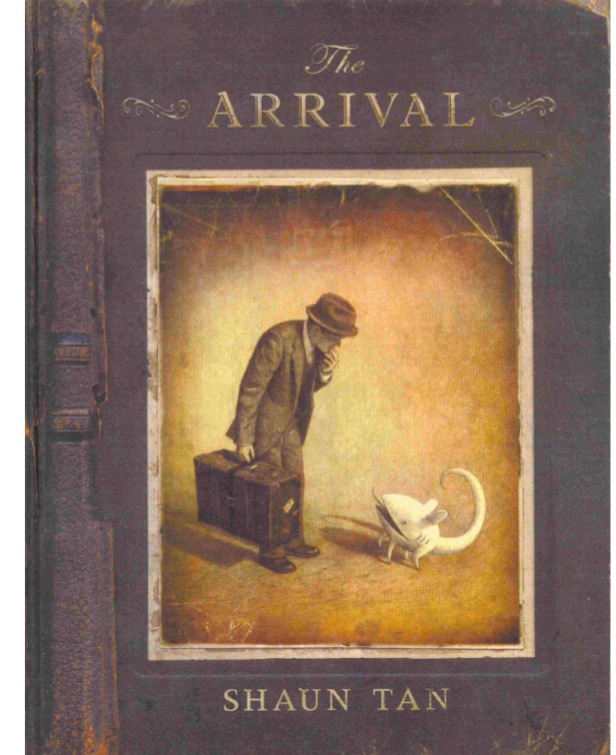I never expected to suggest to you, dear readers, that words, the texture and nuance of language, might not be paramount to great story. I love words. They’ve seduced me as the brine of the sea becomes perfume to the sailor. I hunker down in my seat on the train and soak in the imperfection of casual conversation. Words are currency, inherited, ill-used to glorious effect. The far-flung elements of words combine, chemically, to create catastrophe or cocktail. Vitriol or vintage. Sticks and stones may break your bones, but words will turn all the rest to powder. That, or lift you up and mend you. Neither a force for good nor evil, words are simply power.
But enough semantics, yeah?
There was a time before written or spoken language, and we still often lost ourselves in translation. But we still communicate because we’re bound to do so. We travel to foreign lands and still manage to discover common ground in the creases of our faces, in the universal gestures, and a mutual, omnipresent need to connect.
Today I’d like to showcase a book which, itself, showcases the outright need as well as the incredible capacity for human interaction. I received Shaun Tan’s The Arrival for Christmas. I’d added it to my wish list, not quite knowing what it was. I was taken by the cover, and the image of a traveler encountering a bizarre, unearthly creature. A cursory glimpse at the preview pages reminded me of Chris Van Allsburg’s achromatic illustrations for his children’s book Jumanji. As it turns out, The Arrival is also a picture book, but it employs the sequential storytelling technique of comics. There are no words, but it says a great deal.
 Simply, The Arrival tells the story of a husband and father who travels to a distant land with the hope of finding prosperity for his family. He must leave his wife and daughter in the old country and work to afford their passage so that they might be reunited some day in their new home. It is a story so common and so constant. It is the story of immigrants. And we experience that story as an immigrant in a strange land initially experiences it. Visually.
Simply, The Arrival tells the story of a husband and father who travels to a distant land with the hope of finding prosperity for his family. He must leave his wife and daughter in the old country and work to afford their passage so that they might be reunited some day in their new home. It is a story so common and so constant. It is the story of immigrants. And we experience that story as an immigrant in a strange land initially experiences it. Visually.
The Arrival is enriched by a touch of the fantastic, offering a dreamlike portrayal of the immigrant experience to emphasize just how jarring the transition between cultures can be. It’s universally surreal, so no matter who you are or where you’re from, the introduction of the traveler’s new environment is undeniably wondrous. Whatever real struggles or horrors the man and his family seek to escape are represented as the ominous shadows of a dragon’s tail weaving through the sepia-toned streets. And while the new land at the end of the man’s journey is decidedly far more whimsical and light, it is also foreboding in its scope, in its peculiarities.
Pioneering has an innate learning curve. As someone who has unfortunately never strayed too far from home, I was struck by the perseverance of the traveler in his efforts to decode his new country. In his way, the man is a detective, deciphering visual clues in order to find his way to shelter and food and opportunity. New language, strange language, is a barrier before it serves as a means of communication. So rather than aiding in our hero’s mission, the alien symbols printed on maps, walls, and signposts are daunting icons of confusion. The harbingers of distance and isolation as opposed to community. But through his visual experience, we are privy to something really and truly beautiful. The learning process. Through gridded pages of sequential art, Tan deconstructs that process into its various steps. We witness a gradual understanding, a sensory communication which transcends verbal discourse. Communication, like any dance, requires footwork and precision. We see the struggle, the trial and error. But we also see the connections.

The Arrival really is a book about connections. Though our hero embarks on this journey seemingly alone, his experience is that of community. He meets other immigrants, other refugees. They share their stories and understanding with him. He builds relationships. And the learning process and cultural exchange reveal themselves as cyclical. He embarks upon his journey a lost soul, but finds companionship in that creature from the cover, perhaps analogous of a dog or cat, yet another source of nonverbal kinship. They don’t need words, just the desire to relate.
 Shaun Tan is an astonishing storyteller with a genuine understanding of the comics medium. His layouts are intensely thoughtful. We experience the small moments and the vast landscapes. He has a firm grip on pacing, offering, as I mentioned, the meticulous process of everyday tasks, both as instruction and as an indication of mood. Think of it as an entirely visual movement not unlike music or film. The book opens with the inside cover and first page providing a sixty-panel grid of faces. A landscape of portraits depicting a vast array of people from all across the earth, representing many ages and cultures. Flipping through the pages, there are nine-panel grids with establishing images which define place. There are four-panel montages and twelve-panel grids to relate anecdotal stories. And of course there are two-page spreads which highlight Tan’s profound ability as a graphic artist to create strange and awe-inspiring new worlds. I’m reminded of my favorite painter, Rene Magritte, the famed surrealist. Tan renders the bizarre and foreign and nonsensical as something old and very real. The book itself is presented in the style of a scrapbook, each panel with faded edges like celebrated photographs from a family history. I don’t know that I own many books more beautiful than The Arrival with its images of Escher-esque, metropolitan utopias, haunting and dismal wastelands, and whimsical countrysides. And all of it in meticulously hand-drawn black and white or sepia-toned compositions. No white space, aside from some of the gutters. Just one velvety value drawing after another.
Shaun Tan is an astonishing storyteller with a genuine understanding of the comics medium. His layouts are intensely thoughtful. We experience the small moments and the vast landscapes. He has a firm grip on pacing, offering, as I mentioned, the meticulous process of everyday tasks, both as instruction and as an indication of mood. Think of it as an entirely visual movement not unlike music or film. The book opens with the inside cover and first page providing a sixty-panel grid of faces. A landscape of portraits depicting a vast array of people from all across the earth, representing many ages and cultures. Flipping through the pages, there are nine-panel grids with establishing images which define place. There are four-panel montages and twelve-panel grids to relate anecdotal stories. And of course there are two-page spreads which highlight Tan’s profound ability as a graphic artist to create strange and awe-inspiring new worlds. I’m reminded of my favorite painter, Rene Magritte, the famed surrealist. Tan renders the bizarre and foreign and nonsensical as something old and very real. The book itself is presented in the style of a scrapbook, each panel with faded edges like celebrated photographs from a family history. I don’t know that I own many books more beautiful than The Arrival with its images of Escher-esque, metropolitan utopias, haunting and dismal wastelands, and whimsical countrysides. And all of it in meticulously hand-drawn black and white or sepia-toned compositions. No white space, aside from some of the gutters. Just one velvety value drawing after another.
Imagine a double-page spread featuring sixty panels of cloud forms in neutral tones, no two the same. It’s a quilt. The book isn’t simply a great comic. It’s fine art that tells a story.
And such an important story too. It’s a universal story, and maybe more importantly, a universal story told in a universal way. The best thing about The Arrival is that you can hand this book to any reader, or anyone capable of seeing and identifying images. And they’ll understand it. Because smiles are universal. Art is universal. It succeeds where verbal and written language often fail. Because it’s always been there and you don’t need to acquire it. You just need to share it.




Dang. This looks beautiful.
I have been screaming from the mountain tops about this book for over a year (Hell, I even posted a make shift review on the iFanboy forum a while back).
THIS book is STUNNING!!!! It evokes raw emotion from the reader. I am amazed how many people STILL have not read this masterpiece.
God bless you Paul Montgomery for writing an article about it. 🙂
the Tiki
Those are beautiful images.
Oh my.
This does look amazingly beautiful. I’ll have to check it out!
Damn the artwork is stunning and the review makes want to go right out and buy now now now!
Wow – the art is incredible. I just clicked on the hyperlink – this is really only $14 on Amazon? I am going to have to get this.
I picked this book up at the library, flipped through and admired it, but I didn’t take it home or give it the time it needed, I think, because I was a little perplexed at how to deal with a book that didn’t have words.
You’ve put this very well — I hadn’t thought about the wordlessness tying into the immigrant experience — and I’m going to give the book another look, and some real attention, next chance I get.
I should mention that Shaun Tan has a new book out called Tales From Outer Suburbia, which is a collection of shorter comics also aimed at young adults. Hopefully I can get a hold of that and some of his other books for review. The images I included are just a sampling of his incredible work. Produced in an over-sized format, those big splashes are really stunning.
That’s awesome. Beautiful book! Fantastic opening, Paul- you seduce and mesmerize me. Here’s to hoping you never use your powers for evil
"Imagine a double-page spread featuring sixty panels of cloud forms in neutral tones, no two the same."
I re-read, on a whim, the first chapter of this important piece of fiction just this morning, and was struck at how ingenious the storytelling is. Should the reader slow down and look at each of those sixty panels, he come to understand how Tan has used sequential art to convey just how long the main character’s trip was. And, as Paul pointed out, this is only one example of how this wordless piece can move the reader to experience the longing, the frustration, and the deep satisfaction the main character experiences.
The Arrival is unbelievably impressive. I bought 20 copies for my junior high classroom, and plan on cooperating with a social studies teacher in helping my kids to immerse themselves in this world.
Thanks, Paul, for (hopefully) turning people on to The Arrival.
@BigE – That sounds like a great collaborative project for your classes. Are you incorporating this into coursework? It seems like a great book to use for exploring the immigrant experience. Especially in the sense that you’re not reading about it; you’re experiencing the same culture shock as the main character as he experiences it. I could see a lot of conversation coming out of that.
Another fantastic article Paul!
Books like this I avoid when I am busy. I find that the less the words, the more time spent examining the art.
this looks amazing. the artwork and the story look just amazing!
@PaulMontgomery – That’s exactly what I’m doing. I teach in an extremely ethnically diverse suburb of Chicago, and many (if not most) of my students are either first- or second-generation Americans. I’m really curious to see: a) how parents will react to The Arrival, and b) how my non-immigrant kids will view their immigrant classmates after reading it. While my Language Arts classes can focus on the storytelling and thematic elements, the Social Studies (and possibly ELL and Spanish) teachers could focus on the parallels between historical accounts of migration and the impact of war on emmigration.
I’m geeked. Solid, solid stuff.